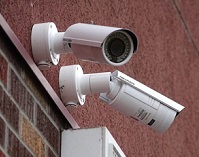
How can AI-based video analytics systems play a role in enhancing property security surveillance systems? Dakota Murphey outlines four top line areas where they are already contributing. With the growing availability and seamlessness of AI and analytics solutions, traditional CCTV surveillance and access control are becoming increasingly more automated and future-proof.
By removing the need for heavy human intervention and repetitive tasks being entrusted to intelligent algorithms, security in commercial properties and residential environments looks set to be enhanced. Provided, of course, that sufficient oversight is exercised, there is reason to believe that AI will be able to make security operations easier.
Despite AI’s growing influence in business, property safety cannot be overlooked. Even if a facility has been accurately and extensively audited for defects and vulnerabilities, it’s unlikely that many threats will be detected and contained before an incident occurs.
AI-powered surveillance and monitoring can transform legacy security systems into highly sophisticated and automated networks that can intelligently identify risks and generate insights in real-time. Ultimately, integrating AI and machine learning (ML) into incumbent security and monitoring systems might seem complicated at first. However, business owners will need to adapt to future-proof vulnerable or at-risk premises. Let’s examine the key benefits AI delivers to maximise property surveillance and protection…
AI algorithms can be programmed to continuously learn and improve from captured video footage and recorded data. AI systems are known for being advantageous at relieving security operatives from tedious, labour-intensive processes, thus freeing up resources.
If an AI system can analyse video inputs and alert users to autonomous detection of incidents, and the presence of individuals, vehicles or objects, it will eliminate the risk of human error. Human operatives will be able to find exact timestamps when incidents occur, thus pinpointing risks and maintaining constant situational awareness with greater accuracy and speed.
Unlike humans, AI-powered camera surveillance can monitor vast networks of security cameras tirelessly without losing concentration. Such systems are ideal for overseeing large premises with many entry and exit points.
Incumbent surveillance systems require security staff to personally review footage, often after a breach or security incident has already occurred. But, AI integration enables real-time alerting of unauthorised activities, intrusions, and other looming threats – ranging from extreme weather conditions to falling objects.
Integrated networks have the potential to identify unusual activity and send notifications at the user’s request to any appropriate designated personnel for swift response. With the ability to ingest footage and cross-reference it with metadata and other data streams, AI systems can quickly make connections. This allows for the seamless and automated detection of risky behaviours, suspicious actions, and security breaches as they unfold.
Most security and CCTV surveillance systems have blind spots in their coverage, particularly for large estates. However, smart AI integration and video analytics can provide additional coverage and oversight using connected cameras.
What’s more, there is a plethora of solutions on the market, ranging from smart alarms, biometrics, keyless door entry, sensors, and 360-degree cameras that allow operatives to detect risks and trespassers in zones with minimal visibility. These can be retrofitted to existing setups and incorporated wherever needed to give property managers a complete, centralised overview of their estate.
AI can be used in ways that extend beyond video capture and timestamps – the systems can interpret activities over a long period, and generate data-driven insights. Smart motion detection, facial recognition, and object classification allow AI-powered systems to understand and recognise ‘normal’ behaviours within a setup.
Security companies can set bespoke rules that dictate what activities and personnel can be considered ‘authorised’, and rules for the algorithms to follow. Any deviations or nefarious activity that breaks these rules can trigger real-time alerts. Built-in machine learning enables systems to continuously improve through experience; the more data it processes, the more attuned it becomes to normal behaviour and movement patterns.
Over time, machine learning algorithms accumulate insights and data about regular patterns of activity. Combining this allows security teams to make strategic, informed decisions, and refine as needed. It’s clear that AI-powered surveillance has the potential to transcend how security operations are conducted, and how risks are mitigated.
With advanced analysis and automated 24/7 monitoring, companies are embracing the AI revolution to transform their day-to-day business while minimising the burden on human resources.
However, as AI systems become more readily available and easy to integrate, property and security managers must exercise caution to ensure that sufficient human control and management are still present. While AI/ML systems can become quickly attuned to normal behaviours and patterns through learning, it’s up to end users to ensure these learned actions are not left to spiral out of control.












